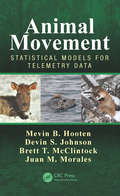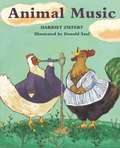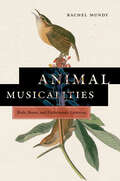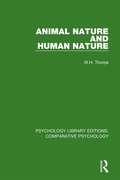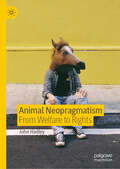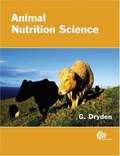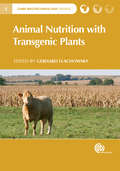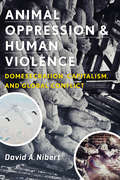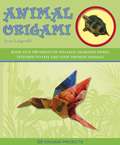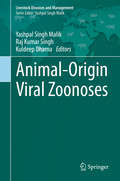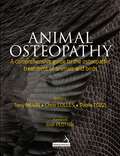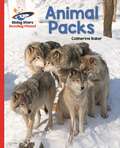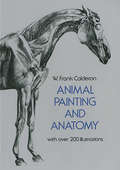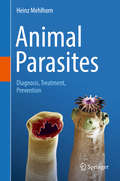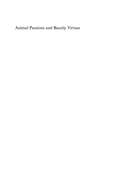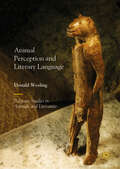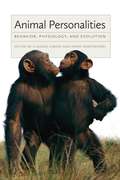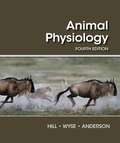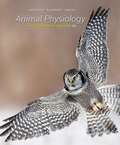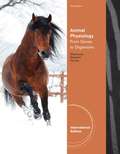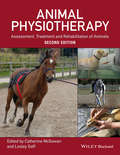- Table View
- List View
Animal Movement: Statistical Models for Telemetry Data
by Mevin B. Hooten Devin S. Johnson Brett T. McClintock Juan M. MoralesThe study of animal movement has always been a key element in ecological science, because it is inherently linked to critical processes that scale from individuals to populations and communities to ecosystems. Rapid improvements in biotelemetry data collection and processing technology have given rise to a variety of statistical methods for characterizing animal movement. The book serves as a comprehensive reference for the types of statistical models used to study individual-based animal movement. Animal Movement is an essential reference for wildlife biologists, quantitative ecologists, and statisticians who seek a deeper understanding of modern animal movement models. A wide variety of modeling approaches are reconciled in the book using a consistent notation. Models are organized into groups based on how they treat the underlying spatio-temporal process of movement. Connections among approaches are highlighted to allow the reader to form a broader view of animal movement analysis and its associations with traditional spatial and temporal statistical modeling. After an initial overview examining the role that animal movement plays in ecology, a primer on spatial and temporal statistics provides a solid foundation for the remainder of the book. Each subsequent chapter outlines a fundamental type of statistical model utilized in the contemporary analysis of telemetry data for animal movement inference. Descriptions begin with basic traditional forms and sequentially build up to general classes of models in each category. Important background and technical details for each class of model are provided, including spatial point process models, discrete-time dynamic models, and continuous-time stochastic process models. The book also covers the essential elements for how to accommodate multiple sources of uncertainty, such as location error and latent behavior states. In addition to thorough descriptions of animal movement models, differences and connections are also emphasized to provide a broader perspective of approaches.
Animal Music
by Harriet ZiefertAn assortment of animals playing various instruments make different kinds of music.
Animal Musicalities: Birds, Beasts, and Evolutionary Listening (Music-culture Ser.)
by Rachel MundyOver the past century and a half, the voices and bodies of animals have been used by scientists and music experts as a benchmark for measures of natural difference. Animal Musicalities traces music’s taxonomies from Darwin to digital bird guides to show how animal song has become the starting point for enduring evaluations of species, races, and cultures. By examining the influential efforts made by a small group of men and women to define human diversity in relation to animal voices, this book raises profound questions about the creation of modern human identity, and the foundations of modern humanism.
Animal Nature and Human Nature (Psychology Library Editions: Comparative Psychology)
by W.H. ThorpeOur views on human nature are fundamental to the whole development, indeed the whole future, of human society. Originally published in 1974, Professor Thorpe believed that this was one of the most important and significant topics to which a biologist can address himself, and in this book he attempts a synthetic view of the nature of man and animal based on the five disciplines of physiology, ethology, genetics, psychology and philosophy. In a masterly survey of the natural order he shows the animal world as part of, yet distinct from, the inanimate world. He then treats aspects of the animal world which approach the human world in behaviour and capabilities, examining simple organisms, communications in vertebrates and invertebrates, innate behaviour versus acquired behaviour, and animal perception. In the second part of the book he deals with those aspects of human nature for which there is no analogy and which constitute man’s uniqueness – his consciousness of his past, his awareness of his future and his desire to understand the meaning of his existence. The primary facts which demonstrate the importance of this book arise from the ever-growing power of man over his environment and his apparent inability to foresee and cope with the dangers of uncontrolled population growth on the one hand and the wildly irrational waste and degradation of the natural resources of the world on the other. Professor Thorpe believes that an immense responsibility lies with literate men of good will, particularly scientists, to convince man that he is the spearhead and custodian of a stupendous evolutionary process. Animal Nature and Human Nature integrates scientific fact with sound theological thought in an attempt to fulfil, in a manner previously impossible Pascal’s injunction that: ‘It is dangerous to show man too clearly how much he resembles the beast without at the same time showing him his greatness. It is also dangerous to allow him too clear a vision of his greatness without his baseness. It is even more dangerous to leave him in ignorance of both. But it is very profitable to show him both.’
Animal Neopragmatism: From Welfare to Rights
by John HadleyThis book affords a neopragmatic theory of animal ethics, taking its lead from American Pragmatism to place language at the centre of philosophical analysis. Following a method traceable to Dewey, Wittgenstein and Rorty, Hadley argues that many enduring puzzles about human interactions with animals can be ‘dissolved’ by understanding why people use terms like dignity, respect, naturalness, and inherent value. Hadley shifts the debate about animal welfare and rights from its current focus upon contentious claims about value and animal mindedness, to the vocabulary people use to express their concern for the suffering and lives of animals. With its emphasis on public concern for animals, animal neopragmatism is a uniquely progressive and democratic theory of animal ethics.
Animal Nutrition Science
by Gordon DrydenWritten for senior undergraduate and graduate students, Animal Nutrition Science introduces the fundamental topics of animal nutrition, in a treatment which deals with terrestrial animals in general. Addressing a wider range of topics than the standard animal nutrition texts, the subjects covered include nutritional ecology and the evolution of feeding styles, nutrients (including minerals, vitamins and water) and their functions, food composition and methods of evaluating foods, mammalian and microbial digestion and the supply of nutrients, control and prediction of food intake, quantitative nutrition and ration formulation, methods of investigating nutritional problems, nutritional genomics, nutrition and the environment, and methods of feed processing and animal responses to processed foods. The many references provide the scientific basis for the text, and give signposts for the reader to extend their enquiry in topics of interest.
Animal Nutrition with Transgenic Plants
by Tj Higgins Jie Wen Klaus Ammann Gerhard Flachowsky Yi Liu Ralf Einspanier Matin Qaim Atte Von Wright Agnes Ricroch Thomas Frenzel Marc De Loose Joachim Scholderer Emilio Rodriguez-Cerezo* Gathers together more than 150 feeding studies with food-producing animals and covers both first and second generation transgenic plants * The first central resource of this information for researchers, students and policy makers * Includes contributions from a wide range of specialists in the field
Animal Nutrition with Transgenic Plants (CABI Biotechnology Series #1)
by Marc De Loose Yi Liu Thomas Frenzel Agnes Ricroch Ralf Einspanier Atte Von Wright Emilio Rodriguez-Cerezo Jie Wen Matin Qaim Joachim Scholderer Tj Higgins Klaus Ammann* Gathers together more than 150 feeding studies with food-producing animals and covers both first and second generation transgenic plants * The first central resource of this information for researchers, students and policy makers * Includes contributions from a wide range of specialists in the field
Animal Offspring: Elephants and Their Calves
by Margaret HallThe Animal Offspring series supports national science standards related to life science. This book describes and illustrates elephants and their calves.
Animal Oppression and Human Violence: Domesecration, Capitalism, and Global Conflict (Critical Perspectives on Animals: Theory, Culture, Science, and Law)
by David NibertJared Diamond and other leading scholars have argued that the domestication of animals for food, labor, and tools of war has advanced the development of human society. But by comparing practices of animal exploitation for food and resources in different societies over time, David A. Nibert reaches a strikingly different conclusion. He finds in the domestication of animals, which he renames "domesecration," a perversion of human ethics, the development of large-scale acts of violence, disastrous patterns of destruction, and growth-curbing epidemics of infectious disease. <P><P>Nibert centers his study on nomadic pastoralism and the development of commercial ranching, a practice that has been largely controlled by elite groups and expanded with the rise of capitalism. Beginning with the pastoral societies of the Eurasian steppe and continuing through to the exportation of Western, meat-centered eating habits throughout today's world, Nibert connects the domesecration of animals to violence, invasion, extermination, displacement, enslavement, repression, pandemic chronic disease, and hunger. In his view, conquest and subjugation were the results of the need to appropriate land and water to maintain large groups of animals, and the gross amassing of military power has its roots in the economic benefits of the exploitation, exchange, and sale of animals. Deadly zoonotic diseases, Nibert shows, have accompanied violent developments throughout history, laying waste to whole cities, societies, and civilizations. His most powerful insight situates the domesecration of animals as a precondition for the oppression of human populations, particularly indigenous peoples, an injustice impossible to rectify while the material interests of the elite are inextricably linked to the exploitation of animals. Nibert links domesecration to some of the most critical issues facing the world today, including the depletion of fresh water, topsoil, and oil reserves; global warming; and world hunger, and he reviews the U.S. government's military response to the inevitable crises of an overheated, hungry, resource-depleted world. Most animal-advocacy campaigns reinforce current oppressive practices, Nibert argues. Instead, he suggests reforms that challenge the legitimacy of both domesecration and capitalism.
Animal Origami: 20 Origami Projects (Origami Books)
by Joost LangeveldBring your favorite animals to life with nothing more than a piece of paper! Animal Origami uses the art of folding to bring you into the wild world of the animal kingdom.Animal Origami offers animal lovers a chance to experience animals in an entirely new way—by creating them! This fun and informative book offers instructions for crafting crabs, cows, dinosaurs, ladybugs, and more.Animals can be intriguing, fun, and fascinating—and with Animal Origami, making them can be all those things too!
Animal-Origin Viral Zoonoses (Livestock Diseases and Management)
by Yashpal Singh Malik Raj Kumar Singh Kuldeep DhamaThis book is the second volume in the series Livestock Diseases and Management, and reviews the importance and implications of animal origin viral zoonoses. It also highlights the specific etiology and epidemiology of these viral infections and discusses their various biological and mechanical transmission mechanisms. Further, the book reviews various measures for controlling viral zoonoses and examines novel therapeutic and prophylactic strategies.Discussing recent studies on the pathogenesis and host immune response to these infections, it underscores the importance of using vaccines against these viral diseases to reduce the risk of them being transmitted to humans.Lastly, it describes in detail the challenges posed by these viral infections and our readiness to face them.
Animal Osteopathy: A comprehensive guide to the osteopathic treatment of animals and birds
by Christopher Colles Anthony Nevin Paolo TozziThis is a comprehensive reference textbook for all those using osteopathic treatment techniques with animals or birds or studying to do so. The book is divided into sections: equine osteopathy; general small animal osteopathy; osteopathy for exotics- (pets such as tortoise, snakes, ferrets etc); osteopathy for wildlife - native as well as non to the UK including species found in most zoological collections; avian osteopathy - both domestic and wild/exotic. Each section covers information specific to that group. This makes the book appropriate for supporting structured post-graduate university validated courses in a clear and easily navigable way.Content includes detailed sections on the differences encountered when working with animals; health and safety around different species; working within the law; integrating with allied professions; anatomy; physiology and patho-physiology; neurology; orthopaedics; differential diagnosis; differential aetiology of presenting conditions when compared to the human model; supportive husbandry and rehabilitation methods.It includes sections covering approaches to patient care; specifics of taking a detailed case history; use of supporting diagnostics; observation; palpation; structuring a treatment programme suitable for each species. Osteopathic treatment techniques and physical patient contact methods are be explained as well as graphically illustrated. All chapters are fully referenced and include revision notes to act as guidelines for the reader.It is intended primarily for post-graduate osteopaths intending to work with animals or who are already doing so. It will also strongly appeal to vets as well as to other allied professions working with animals (eg massage therapists).
Animal Painting and Anatomy
by W. Frank CalderonDrawing is "the very essence of all pictorial art," and this book approaches the challenging art of animal painting from the point of view of accurate representation of animal subjects on canvas. Combining useful information on important anatomical features with direction on how to handle the subjects and how to express their forms and postures, the author has produced a complete, inexpensive, at-home course in animal painting and anatomy.All aspects of animal drawing and painting are covered: drawing from life; anatomy in relation to drawing (not surgical anatomy, but a precise knowledge of the visible structure and movements of animals); characteristic movements of animals and suggestions on how to capture them in your picture; composition (design, restraint, rhythm, balance of light and shade, relative scale of animals and landscape, foregrounds); painting and color. 36 illustrations, mostly sketches by the author, depict horses, pigs, cows, dogs, and other animals in various life positions and movements. A long, detailed discussion of the anatomy of animals completes the book. Here Mr. Calderon describes all the structures of animals that are of significance to the artist: the vertebral skeleton, the bones and muscles of the head, the muscles of the vertebral skeleton, the fore-limb and its muscles, the muscles attaching the shoulder blade to the trunk, and the bones and muscles of the hind limb. 208 drawings accompany these discussions and show you how anatomy is related to surface contours and techniques of shading.
Animal Parasites: Diagnosis, Treatment, Prevention
by Heinz MehlhornThis textbook focuses on the most important parasites affecting dogs, cats, ruminants, horses, pigs, rabbits, rodents, birds, fishes, reptiles and bees. For each parasite, the book offers a concise summary including its distribution, epidemiology, lifecycle, morphology, clinical manifestations, diagnosis, prophylaxis and therapeutic measures. Numerous informative tables and more than 500 color micrographs and schemes present the most important aspects of the parasites, their induced diseases and the latest information on suitable prevention and control measures. 100 questions at the end of the book offer readers the chance to test their comprehension. The book is well suited as both a textbook and a reference guide for veterinarians, students of the veterinary and life sciences, veterinarian nurses, laboratory staff, and pet and livestock owners.
Animal Passions and Beastly Virtues: Reflections on Redecorating Nature
by Bekoff Marc Goodall JaneWho hasn't wondered what it's like to be a dog or bird? Such questions seem unanswerable because we have no way of getting into an animal's mind. Marc Bekoff's work on animal behavior and mind draws world-wide attention for its originality and its probing into what animals might know as well as what skills (mental and physical) are needed to live life successfully as a member of a particular species. Convinced that individuals of every species have some level of self-awareness, Bekoff embarks on fascinating (and often amusing) observations of animals playing, leaving and detecting scent-marks, solving problems, and behaving fairly toward each other. Animal Passions and Beastly Virtues brings together some of his path-breaking research papers, essays on science and ethics, and popular articles in order to reveal a remarkable range of animal behaviors but also to argue that the ethical treatment of animals is an especially significant issue now.
Animal Perception and Literary Language (Palgrave Studies in Animals and Literature)
by Donald WeslingAnimal Perception and Literary Language shows that the perceptual content of reading and writing derives from our embodied minds. Donald Wesling considers how humans, evolved from animals, have learned to code perception of movement into sentences and scenes. The book first specifies terms and questions in animal philosophy and surveys recent work on perception, then describes attributes of multispecies thinking and defines a tradition of writers in this lineage. Finally, the text concludes with literature coming into full focus in twelve case studies of varied readings. Overall, Wesling's book offers not a new method of literary criticism, but a reveal of what we all do with perceptual content when we read.
Animal Personalities: Behavior, Physiology, and Evolution
by Claudio Carere Dario MaestripieriAsk anyone who has owned a pet and theyOCOll assure you that, yes, animals have personalities. And science is beginning to agree. Researchers have demonstrated that both domesticated and nondomesticated animalsOCofrom invertebrates to monkeys and apesOCobehave in consistently different ways, meeting the criteria for what many define as personality. But why the differences, and how are personalities shaped by genes and environment? How did they evolve? The essays in "Animal Personalities "reveal that there is much to learn from our furred and feathered friends. aaaaaaaaaaa The study of animal personality is one of the fastest-growing areas of research in behavioral and evolutionary biology. Here Claudio Carere and Dario Maestripieri, along with a host of scholars from fields as diverse as ecology, genetics, endocrinology, neuroscience, and psychology, provide a comprehensive overview of the current research on animal personality. Grouped into thematic sections, chapters approach the topic with empirical and theoretical material and show that to fully understand why personality exists, we must consider the evolutionary processes that give rise to personality, the ecological correlates of personality differences, and the physiological mechanisms underlying personality variation.
Animal Physiology
by Richard W. Hill Margaret Anderson Gordon A. WyseAnimal Physiology presents all the branches of modern animal physiology with a strong emphasis on integration of physiological knowledge, ecology, and evolutionary biology. Integration extends from molecules to organ systems and from one physiological discipline to another.
Animal Physiology
by Knut Schmidt-NielsenIn this revised, updated, two-color edition of the acclaimed text Animal Physiology, Knut Schmidt-Nielsen introduces and develops the fundamental principles of animal physiology according to major environmental features--oxygen, food and energy, temperature, and water. The book is structured the same as the previous edition, but every chapter has been updated to take into account recent developments, with numerous new references and figures. New and expanded features include: extensive modifications to the chapter on Movement, Muscle and Biomechanics; new material on respiratory pigments; feeding and digestion in shrimp and hoatzin; plant defense compounds; diving in seals; high temperature tolerance; the patch clamp method for ion channel research; the pineal gland and melatonin. Two-color throughout for clear description and illustration of fundamental principles.
Animal Physiology: From Genes to Organisms
by Lauralee Sherwood Hillar Klandorf Paul YanceyPromoting a conceptual understanding and taking an integrative systems approach, ANIMAL PHYSIOLOGY 2E illustrates the individual organization as well as the collective interdependence of each complete physiological system. <p><p>The text begins with chapters on integrative principles and on the genomic, molecular, and cellular basis of physiology, then proceeds to chapters on individual organ systems. For each organ system, evolutionary forces as well as current cellular and molecular research are discussed. To clearly illustrate system interdependence, each systems chapter contains a summary, titled "Making Connections." <p><p>To make the text even more accessible to students, the authors also incorporate a comparative approach to animal physiology, examining the basic physiology of many vertebrate and nonvertebrate animals as well as their primary diseases and ability to respond to environmental changes.
Animal Physiology: From Genes to Organisms (2nd Edition)
by Paul Yancey Lauralee Sherwood Hillar KlandorfPromoting a conceptual understanding and taking an integrative systems approach, ANIMAL PHYSIOLOGY, 2E, International Edition illustrates the individual organization as well as the collective interdependence of each complete physiological system. The text begins with chapters on integrative principles and on the genomic, molecular, and cellular basis of physiology, then proceeds to chapters on individual organ systems. For each organ system, evolutionary forces as well as current cellular and molecular research are discussed. To clearly illustrate system interdependence, each systems chapter contains a summary, titled "Making Connections. " To make the text even more accessible to students, the authors also incorporate a comparative approach to animal physiology, examining the basic physiology of many vertebrate and nonvertebrate animals as well as their primary diseases and ability to respond to environmental changes.
Animal Physiotherapy: Assessment, Treatment And Rehabilitation Of Animals
by Catherine Mcgowan Lesley GoffA thoroughly updated edition of this essential reference guide for physiotherapists and physical therapists, looking to apply the proven benefits of physiotherapy to the treatment of companion and performance animals. Seven new chapters provide greatly expanded coverage of practical treatment and rehabilitation Includes reviews of different physiotherapy techniques, drawing on both human and animal literature Discusses approaches in small animal medicine as well as for elite equine athletes Provides applied evidence-based clinical reasoning model, with case examples Now in full colour with many more illustrations
